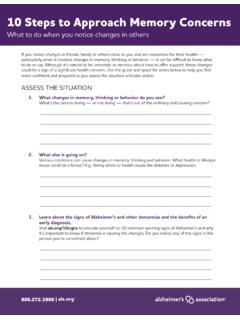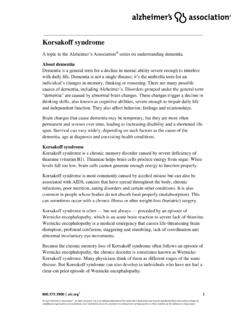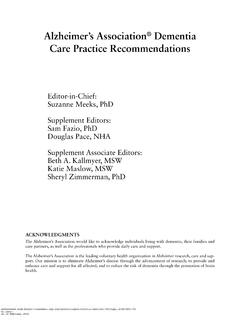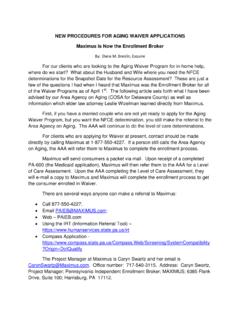Transcription of 2018 ALZHEIMER’S DISEASE FACTS AND FIGURES
1 2018 ALZHEIMER S DISEASE FACTS AND FIGURESI ncludes a Special Report on the Financial and Personal Benefits of Early DiagnosisAlzheimer s Association. 2018 Alzheimer s DISEASE FACTS and FIGURES . Alzheimers Dement 2018;14(3) this report2018 Alzheimer s DISEASE FACTS and FIGURES is a statistical resource for data related to Alzheimer s DISEASE , the most common cause of dementia. Background and context for interpretating the data are contained in the Overview. Additional sections address prevalence, mortality and morbidity, caregiving and use and costs of health care and services. A Special Report discusses the financial and personal benefits of diagnosing earlier in the DISEASE process, in the stage of mild cognitive Alzheimer s DISEASE FACTS and FiguresSpecific information in this year s Alzheimer s DISEASE FACTS and FIGURES includes: Brain changes that occur with Alzheimer s DISEASE (page 8).
2 Revised guidelines for diagnosing Alzheimer s DISEASE (page 15). Number of Americans with Alzheimer s dementia nationally (page 17) and for each state (page 19). Proportion of women and men with Alzheimer s and other dementias (page 18). Lifetime risk for developing Alzheimer s dementia (page 22). Number of deaths due to Alzheimer s DISEASE nationally (page 25) and for each state (page 27), and death rates by age (page 29). Number of family caregivers, hours of care provided, and economic value of unpaid care nationally and for each state (page 34). The impact of caregiving on caregivers (page 34). National cost of care for individuals with Alzheimer s or other dementias, including costs paid by Medicare and Medicaid and costs paid out of pocket (page 43).
3 Medicare payments for people with dementia compared with people without dementia (page 46). Benefits of earlier detection of Alzheimer's DISEASE . (page 62). Cost savings of diagnosing during the earlier mild cognitive impairment stage rather than the dementia stage (page 64).The Appendices detail sources and methods used to derive statistics in this report. When possible, specific information about Alzheimer s DISEASE is provided; in other cases, the reference may be a more general one of Alzheimer s or other dementias. What Is Alzheimer s Dementia ?A Note About TerminologyAs discussed in the Overview (page 4), under the 1984 diagnostic guidelines, only individuals with symptoms such as significant problems with learning, thinking or memory could receive a diagnosis of Alzheimer s DISEASE .
4 Under the 2011 guidelines, however, individuals could receive a diagnosis of Alzheimer s DISEASE if they had the brain changes of Alzheimer s that precede the onset of symptoms; if they had the subtle symptoms of mild cognitive impairment due to the brain changes of Alzheimer s; and if they had significant problems with learning, thinking or memory (dementia) due to the brain changes of Alzheimer s. The 2011 guidelines build upon research suggesting that Alzheimer s DISEASE encompasses a continuum beginning with the initial brain changes of Alzheimer s that start years before symptoms appear, continuing with years of symptoms that affect cognitive and physical function, and ending with severe Alzheimer s, when brain changes are so extensive that individuals can no longer walk and struggle to communicate.
5 As a result, what was Alzheimer s DISEASE under the 1984 guidelines is called dementia due to Alzheimer s or Alzheimer s dementia under the 2011 guidelines one stage in the continuum of the edition of Alzheimer s DISEASE FACTS and FIGURES reflects this change in understanding and terminology. That is, the term Alzheimer s DISEASE is now used only in those instances that refer to the underlying DISEASE or the entire continuum of the DISEASE . The term Alzheimer s dementia is used to describe the dementia stage of the continuum. Thus, in most instances where past editions of the report used Alzheimer s DISEASE , the current edition uses Alzheimer s dementia.
6 The data examined are comparable across editions only the way of describing the affected population has s Association. 2018 Alzheimer s DISEASE FACTS and FIGURES . Alzheimers Dement 2018;14(3) 5 Alzheimer s DISEASE 5 Symptoms of Alzheimer s Dementia 5 Diagnosis of Alzheimer s Dementia 8 Brain Changes Associated with Alzheimer s DISEASE 8 Mild Cognitive Impairment: A Potential Precursor to Alzheimer s and Other Dementias 10 Genetic Abnormalities Associated with Alzheimer s DISEASE 10 Risk Factors for Alzheimer s DISEASE 10 Treatment of Alzheimer s Dementia 13 Living with Alzheimer s Dementia 14A Modern Diagnosis of Alzheimer s DISEASE .
7 Revised Guidelines 15 PrevalencePrevalence of Alzheimer s and Other Dementias in the United States 17 Estimates of the Number of People with Alzheimer s Dementia by State 21 Incidence of Alzheimer s Dementia 21 Lifetime Risk of Alzheimer s Dementia 22 Trends in the Prevalence and Incidence of Alzheimer s Dementia 22 Looking to the Future 22 Growth of the Oldest-Old Population 23 Mortality and MorbidityDeaths from Alzheimer s DISEASE 25 Public Health Impact of Deaths from Alzheimer s DISEASE 26 State-by-State Deaths from Alzheimer s DISEASE 26 Alzheimer s DISEASE Death Rates 28 Duration of Illness from Diagnosis to Death 28 Burden of Alzheimer s DISEASE 28 CONTENTS3 CaregivingUnpaid Caregivers 31 Who Are the Caregivers?
8 31 Caregiving and Women 32 Caregiving Tasks 32 Duration of Caregiving 34 Hours of Unpaid Care and Economic Value of Caregiving 34 Impact of Alzheimer s Caregiving 34 Interventions Designed to Assist Caregivers 39 Paid Caregivers 40 Direct-Care Workers for People with Alzheimer s or Other Dementias 40 Shortage of Geriatric Health Care Professionals in the United States 40 Enhancing Health Care for Family Caregivers 41 Trends in Dementia Caregiving 41 Use and Costs of Health Care, Long-Term Care and HospiceTotal Cost of Health Care and Long-Term Care 43 Use and Costs of Health Care Services 44 Use and Costs of Long-Term Care Services 48 Use and Costs of Health Care and Long-Term Care Services by Race/Ethnicity 55 Avoidable Use of Health Care and Long-Term Care Services 55 Projections for the Future 57 Potential Impact of Changing the Trajectory of Alzheimer s DISEASE 57 Special Report Alzheimer s DISEASE .
9 Financial and Personal Benefits of Early DiagnosisAn Evolving Understanding of Alzheimer's DISEASE 59 Changing Diagnostic Criteria 60 Benefits of Early Detection and Diagnosis for People Living with Alzheimer s and Caregivers 62 Financial Benefits of Early Diagnosis 64 Conclusions 66 AppendicesEnd Notes 68 References 71 ContentsOVERVIEW before symptoms appear, brain changes associated with Alzheimer s DISEASE may s DISEASE is a degenerative brain DISEASE and the most common cause of Dementia is a syndrome a group of symptoms that has a number of causes.
10 The characteristic symptoms of dementia are difficulties with memory, language, problem-solving and other cognitive skills that affect a person s ability to perform everyday activities. These difficulties occur because nerve cells (neurons) in parts of the brain involved in cognitive function have been damaged or destroyed. In Alzheimer s DISEASE , neurons in other parts of the brain are eventually damaged or destroyed as well, including those that enable a person to carry out basic bodily functions such as walking and swallowing. People in the final stages of the DISEASE are bed-bound and require around-the-clock care. Alzheimer s DISEASE is ultimately an individual has symptoms of dementia, a physician will conduct tests to identify the cause.













